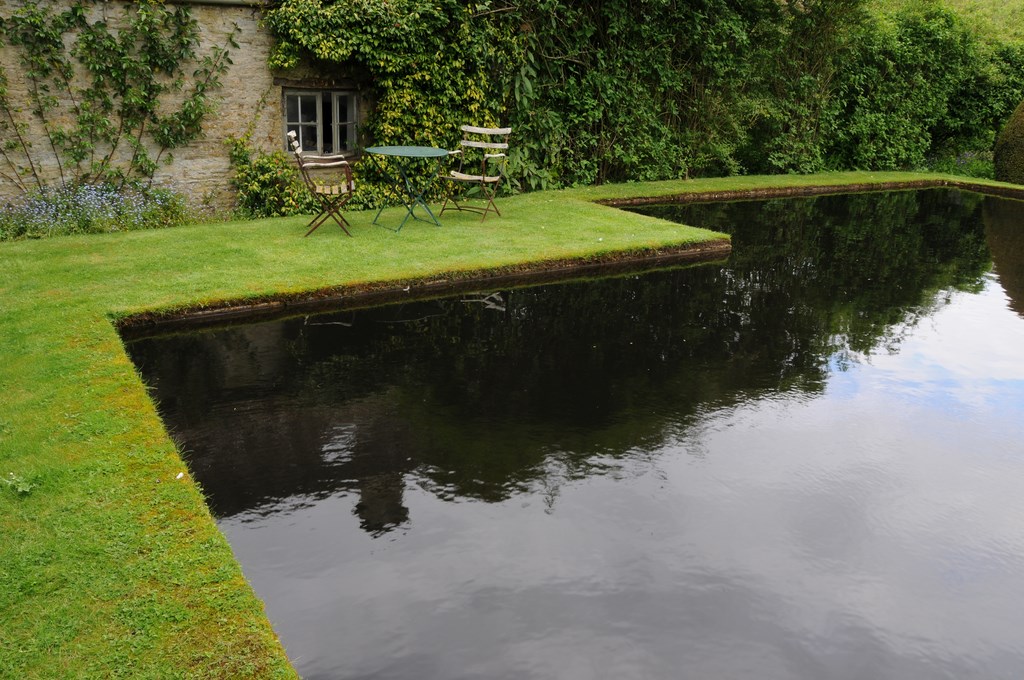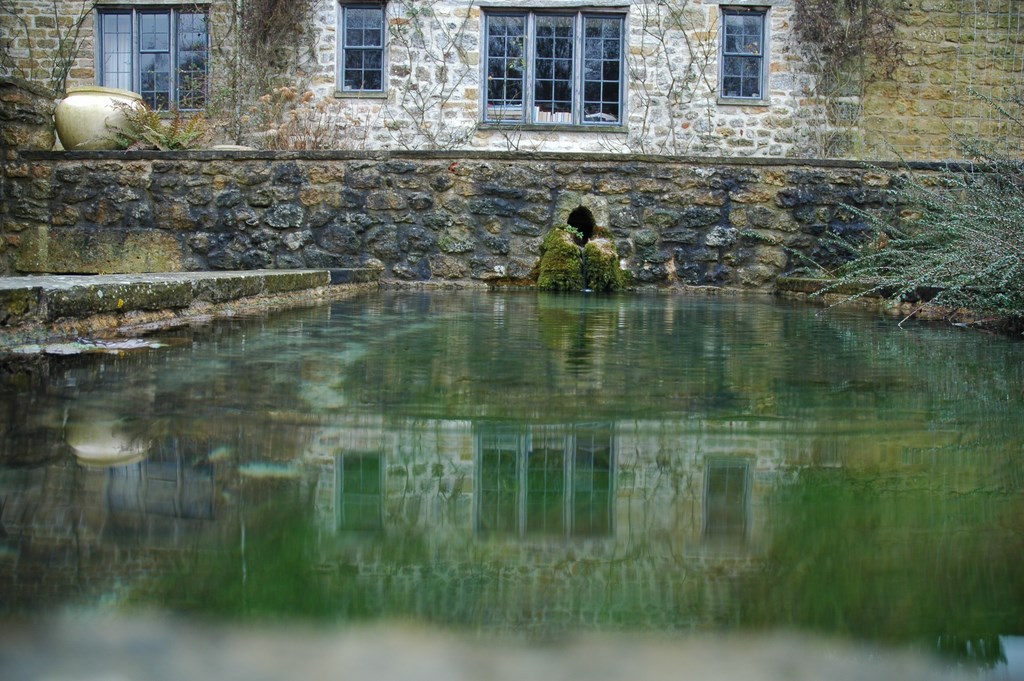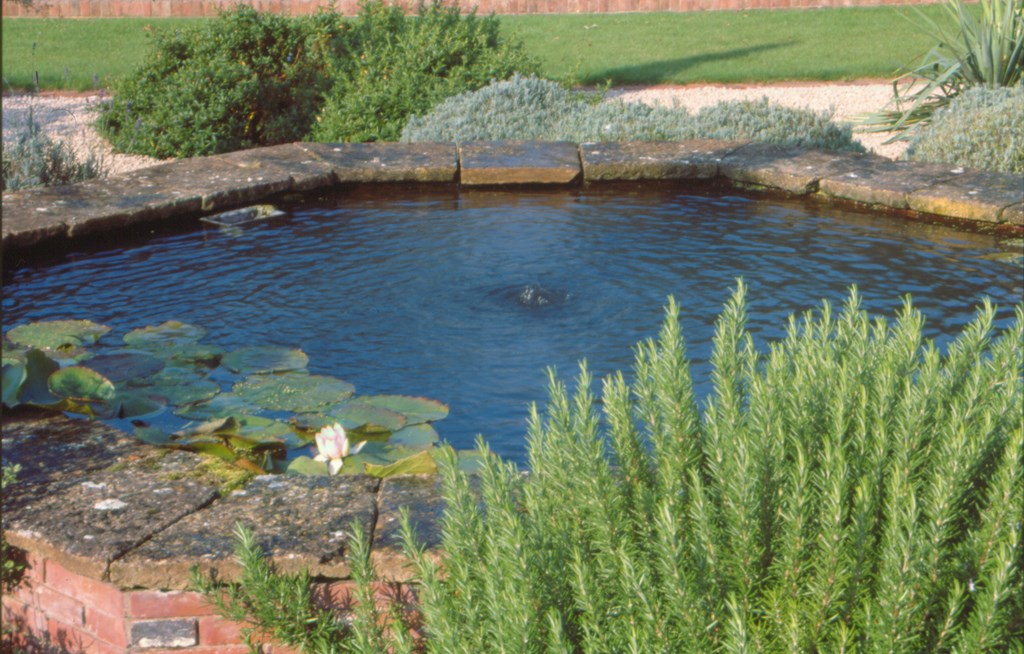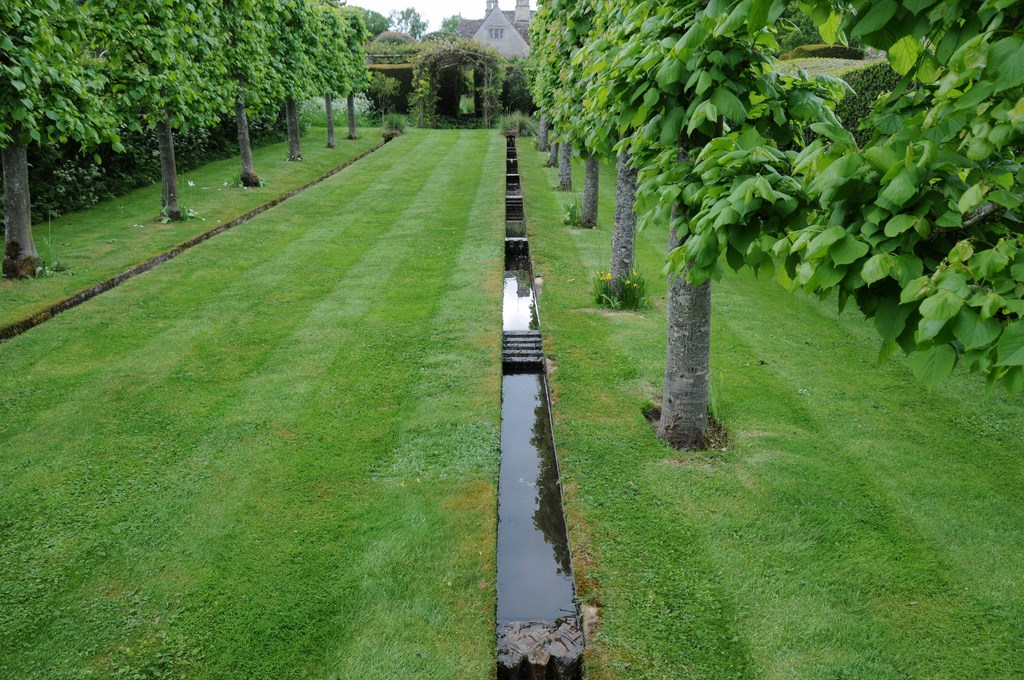A Human Touch


As a rule, those of us who build watershapes meant for purposes other than swimming or hydrotherapy tend to pursue one path or another: Either we make our ponds, streams and waterfalls look as natural as we can manage, or we establish them to reveal the hand of man either partly or completely. In that either/or context, successful design depends at least in part on being perfectly clear with ourselves about what we are trying to achieve.
In assessing ponds of these opposing forms, it’s my personal practice to look at both natural ponds and formal ponds (or, more accurately, architectural ponds) as being right on par with one another with respect to their potential for beauty. Indeed, architectural ponds can be incredibly appealing when done up in such a way that
they reflect a particular style of architecture and accentuate and capitalize upon aesthetic partnerships.
In deciding which way to go, it all boils down to a question of which approach will be more striking in a particular setting.
In this article, I’m going to depart from the naturalistic train of thought that has characterized much of what I’ve written about in WaterShapes in recent years and will focus my attention instead on ponds with an architectural bent. My aim is to explore the opportunity these watershapes give us not only to harmonize with architecture, but also to create bold juxtapositions with nature or take advantage of the opportunity to combine forms and make a setting so much more appealing.
SEEING ANEW
Growing up in England, I spent a lot of time within easy reach of natural bodies of water in the form of lakes, ponds, streams and rivers that ripple the countryside – and I’ve drawn inspiration from them ever since.
At an early age, however, I was exposed to architectural ponds through my grandparents, who owned several country homes at which I noticed formal ponds referred to as “lily tanks” – simple rectilinear ponds that were used exclusively for growing water lilies, which were pretty much the only aquatic plants one could obtain back then.
These ponds were made of stone, concrete or brick – often with raised and crumbling edges – and there were little ones usually lined with lead or zinc. The water was invariably clear because the plants consumed all of the available nutrients, and I still remember the beautiful white and the occasional red flowers that emerged. Watergardening was a rare hobby in those days, and my mother was a particularly enthusiastic participant.
Later on, my initial professional interest in watergardening was almost entirely a matter of pursuing the replication of nature, but the austere lily tanks I remembered from childhood came back to me when I began to grow water plants on my own and I began taking more than a casual interest in what was going on in the water. That was the humble trigger for my interest in ponds of a more architectural form.
| The capacity of architectural fountains to define or call attention even to small, out-of-the-way spaces is among their greatest virtues. Indeed, they can be almost any size and placed almost anywhere, giving us tremendous flexibility in deciding how to use them as part of grander design schemes. |
In traveling across the United Kingdom, my interest in these watershapes grew as I noted how many country houses and large estates were adorned with some form of architectural pond, usually in the Victorian style. In addition, those I saw were very often in a dilapidated state – a fact that generally made them seem more beautiful to me as I observed the way time had worn on the materials and how nature in some cases seemed intent on breaking down the very stone of which the ponds’ structures were composed.
What I also came to notice is that these architectural ponds afforded whoever installed them the opportunity to bring water into spaces that simply could not have supported any other kind of watershape. Where naturalistic watergardens frequently need large areas to achieve an appropriately natural appearance, I saw that these architectural ponds could be placed almost anywhere – and often in the most unlikely spots in tiny courtyards, patios or terraces or even on the occasional balcony.
They give us, in other words, tremendous flexibility in positioning water and how it can be used as part of a larger design scheme. In some cases, these ponds will be the only body of water on a property; in others, they herald the presence of other waterfeatures. Similarly, they might be a retiring feature partly hidden off off to the side somewhere, quietly beckoning one to walk over to take full notice of them – or they can be the centerpiece of a space around which an entire, broad garden revolves.
There’s really no limit to how architectural ponds can be used, so long as there’s a deliberate reasoning behind their presence in a given space.
TIMELESS QUALITIES
I must come back to flexibility for a moment, because there’s so much to tell about the ways in which architectural ponds can be used.
They can be subordinate part of fountains, with water flowing into them via spouts or around raised fountain bowls – or strong architectural features in their own right. They can serve as basins for wall-mounted fountains or as simple tanks in which water lilies or emergent plants are the only things you notice. In my own work, I delight in creating tiny waterfeatures that lend atmosphere to spaces that might otherwise be completely featureless and obscure.
It doesn’t take much to instill even a modest setting with an almost magical presence: Just adding water and plants (or water’s sound and motion) is all it takes to transform the experience of passing from one area into another.
Indeed, even a tiny architectural pond can be established as a destination, as a place where people can step aside and have a quiet conversation or simply reflect on the beauty of the plants or reflections – much as they would in the presence of a much larger body of water that would provide far more expansive views. There can be an intimacy to these ponds that is really very special and makes them cherished for what they bring to their settings: I love, for example, the way they can provide focal points seen from inside a home that draw the eye out to the garden, inviting one out for a closer look.
| I’m intrigued by the possibility of bringing the architectural together with the natural and of making it seem as though one part of a pond has been tamed for our use while another part reflects the water’s untrammeled, natural, ancient state. It’s a philosophical bridge between forms – and a profound way to reveal the hand of man in otherwise wild-seeming settings. |
None of this is to imply that formal ponds can’t be large or, as do naturalistic ponds, provide wonderful reflections of adjacent structures, statuary, trees or other objects of visual significance. Where they can be made large, they bring the potential of bouncing light up into dark rooms or producing dramatic reflections off their mirrored surfaces. Just like their naturalistic cousins, these large watershapes can lend a sense of intimacy to a grand setting or one of importance to an otherwise insignificant space.
No matter the scale or setting, of course, the key to effective use of an architectural pond is the same one that opens the doors of good design for all watershapes: When used in a deliberate and purposeful way, architectural ponds can be placed in almost any type of setting with any sort of architectural style, from classic to contemporary. On that level, success is, as always, about good and appropriate design.
As you review the following clusters of images and their associated text, please bear one last set of observation in mind, starting with the point that geometric enclosures for water date back to the most ancient reaches of civilization.
From the Greeks and Romans on through Islamic cultures and the formal design traditions of Europe, what we see in these geometries is a desire to impose order on the untamed spasms of nature. A long, rectilinear pond at a building’s entrance, for example, would give a visitor a feeling of psychological or even physical comfort stemming from the presence of an ordered aquatic structure. This expression of our ability to control nature is a likely reason why architectural ponds have a place in almost all design traditions.
CROSSING BRIDGES
In today’s world, however, we’ve come full circle to a place where our surroundings are so orderly that we have the desire to make naturalistic elements stand out amid the rigidity of our cities. That state of affairs also brings this discussion in a full circle and carries me back to the combination of impulses I mentioned at the outset.
With architectural ponds, we have an amazing opportunity combine the formal with the natural in forms I see as representing the best of both worlds. Given a blank
canvas, for example, we can create a natural-looking body of water on one side with brimming edges and emergent plants as might have been formed by nature itself; then we came along, adding a wooden deck on the other side – or a brick or stone terrace. With one side natural and the other architectural, it leaves us with the impression that someone tamed a portion of the space for their use without utterly destroying a natural setting.
Achieving that sort of balance represents a challenge that’s been in play from civilization’s very first attempts to bring water into constructed environments, and it’s my belief that, in exploring these concepts in our own projects, we not only grapple with the intricacies of those challenges but also participate in watershaping’s traditions in the most profound ways possible.
An Affinity for Age
Growing up in England and having had the privilege of traveling over much of the world, I’ve developed a passion for architectural ponds that look old. Many of these watershapes have been there for a very long time, and it’s fascinating to observe the ways in which the elements have overtaken their man-made structures and had its way with bodies of water that originally stood quite apart from nature.
I have the same affection for the timeless beauty and charm of very old buildings on which the stones or bricks have weathered and the mortar has worn away. I also love roofs completely covered in lichen or moss as well as walls, pathways and other structures embraced or consumed by plants. It’s as if these objects of our craft are being taken back into the bosom of nature.
In places where these structures have been in place for hundreds of years, they’ve become so fused together that it’s sometimes difficult to tell where craft ends and nature begins. With just a fleeting glance, you can almost sense the passage of time; with a closer look, you perceive the infinitely complex relationships between structures and nature.
Best of all, when you combine that aged or aging appearance (genuine or manufactured) with the comforting presence of water, there’s a power there that provides people with profound feelings of comfort.
These objects that have been around a long time give us sensations of stability and permanence – valuable commodities in a world full of disposable items and places that aren’t meant to last. At the same time, water allows change to mingle with stability: Water lilies, hyacinths and emergent grasses change as they grow, and we get an inkling of the contrasts, even subconsciously, in settings that might seem to be old and unchanging.
This is why old materials that perhaps have been reclaimed from other structures are so powerful when used to construct architectural ponds. By doing so, you pick up on the work nature has done with the passage of time to make a fresh aesthetic statement. And while there are techniques and products that can be used to create that look artificially, to my eyes there is no substitute for the real thing and the subtle, beautiful, entirely random effects of age.
Shapes and Settings
Where the occasion rises, I’ve always loved octagonal ponds either set at ground level or raised for seating because of the multiplicity of ways they function in garden spaces. They are wonderfully balanced – geometric and architectural yet soft at the same time – and work particularly well in gardens where paths and planting areas emanate from a center the pond defines.
Rectangular ponds can be wonderful, too, by directing the eye across linear views to a piece of nearby sculpture or off into the distance. Their value may alternatively or conjointly be as reflective surfaces that mirror a home or some other significant structure. Either way, architectural ponds have an amazing ability to link spaces and objects visually that would otherwise seem distant and completely disconnected from one another.
This need for connectedness is yet another reason why, as in all forms of garden design or watershaping, there is a responsibility on the part of the designer to respond appropriately to the setting and the overall environment. With architectural ponds, I’d even argue that there is a greater need to be sensitive to the setting than there is with naturalistic ponds.
This is so because, at a minimum, we as designers respond to those two types of ponds very differently. In naturalistic work, we follow the dictates of nature: Although these ponds may exist comfortably in the presence of built environments, they will always be separate from them: Nature rules, no matter what.
That’s not the case with architectural ponds: As a designer, we must respond directly to the architecture of the home or other surrounding structures, and that adherence to a style almost always means selecting materials that are the same or very similar to what’s already there on site as well as using shapes that echo existing architectural forms. Unless there’s some very direct reason to do otherwise, we are constrained within an existing design scheme and by the need to maintain a harmony of materials.
Power in Simplicity
I believe that the job of the pond designer is to avoid doing anything that disrupts feelings of tranquility and repose. If the structure containing the water makes too bold a statement or somehow appears out of place, then we run the risk of jarring the person experiencing the water and of compromising or destroying the desired visual and psychological effects.
This is an area in which I believe we have much to learn from the traditions of Japanese gardening – despite the fact that our Western approach to architectural ponds may seem at odds with the way Japanese gardeners keep their forms so simple and direct, especially when working in small spaces. Indeed, they won’t do anything to upset the meditative quality of a setting, which is precisely where I see a connection to the architectural ponds I admire most.
Look at it this way: Water always forms a confined, dead-level plane and therefore must be precisely placed in the context of any surrounding structures. In effect, we are setting distinct boundaries for a highly reflective plane of liquid. The materials surrounding the water may be aged or rough-hewn in appearance and the water may be host to ever changing plant materials, but the plane of the water will always remain precisely the same. As a consequence, there’s an advantage to using deliberate, easily understood forms because they create a sense of balance with the unavoidable precision the water’s level.
Organized with care, the container’s simple lines can be used to achieve a range of effects, be it tapering, bordering, magnifying or reflecting corresponding shapes in the setting as the situation allows. The principle to remember here is that these lines create a sense of stability that is restful for the eye. In many situations, this plays out simply by keeping the lines of the pond parallel to the shape of an adjacent building or the line created by a line of trees or hedges.
The organization of these primary lines must be congruent with other elements nearby or the effect can be extremely jarring – as would be the case in pointing the corner of a pond at the straight line of a wall. The visual conflict thus created will disrupt any sense of balance and tranquility and invoke the discomfort of instability in exact opposition to Japanese garden philosophy. When there’s a picture on a wall that’s not hanging properly, we don’t see the painting, just the fact that it needs to be straightened!
Anthony Archer Wills is a landscape artist, master watergardener and author based in Copake Falls, N.Y. Growing up close to a lake on his parents’ farm in southern England, he was raised with a deep appreciation for water and nature – a respect he developed further at Summerfield’s School, a campus abundant in springs, streams and ponds. He began his own aquatic nursery and pond-construction business in the early 1960s, work that resulted in the development of new approaches to the construction of ponds and streams using concrete and flexible liners. The Agricultural Training Board and British Association of Landscape Industries subsequently invited him to train landscape companies in techniques that are now included in textbooks and used throughout the world. Archer Wills tackles projects worldwide and has taught regularly at Chelsea Physic Garden, Inchbald School of Design, Plumpton College and Kew Gardens. He has also lectured at the New York Botanical Garden and at the universities of Miami, Cambridge, York and Durham as well as for the Association of Professional Landscape Designers and the Philosophical Society. He is a 2008 recipient of The Joseph McCloskey Prize for Outstanding Achievement in the Art & Craft of Watershaping.














